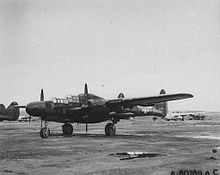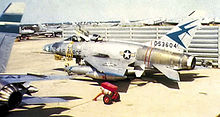416th Fighter Squadron
[1] After completing its initial training by April 1943, the squadron crossed the Atlantic on the RMS Queen Elizabeth and landed in the United Kingdom on 11 May.[1] Upon arrival in England the squadron received additional training with Royal Air Force night fighter units at several bases in early 1943 achieving the first victory on 24 July.There, the squadron fell under the operational control of the Northwest African Coastal Air Force, a Combined allied organization with British, Free French, and other American units.During its first year there, the squadron patrolled harbors and escorted shipping; however, in September 1944 the 416th shifted to more aggressive activities to provide defensive cover for the American Fifth Army and make intruder sweeps into enemy territory.[2] It also continued defensive patrols and offensive night attacks on Axis positions on Sardinia, Corsica, and in Southern France.Next, the squadron joined its parent unit, the 21st Fighter-Bomber Group, in Operation Boxkite at North Field, South Carolina from 17 April to 15 May 1954.From 17 October through 7 December 1964, the squadron deployed a flight to Takhli Royal Thai Air Force Base, Thailand, where it operated under various higher headquarters.The unit's participation in Commando Sabre continued after the detachment moved to Tuy Hoa Air Base and they came under the operational control of the 31st Tactical Fighter Wing.After this quartet trained the other dozen, planes from this detachment would fly missions into North Vietnam's Route Package 1 or against the defenses of the Ho Chi Minh Trail in Operation Steel Tiger.Their standard operating profile of 450 Knots indicated air speed at 4,500 feet altitude above ground level allowed their survival where slow FACs dared not venture.The 1 April 1968 cessation of bombing north of the 20th Parallel intensified operations in Route Package 1 and increased the Misty FAC workload.[7] With 1 November 1968 halt of bombing North Vietnamese targets, the Mistys ceased operations in Route Package 1 and shifted their FAC mission towards the Ho Chi Minh Trail.[8] From 1 November 1968 until June 1969, the Mistys flew 1,530 combat sorties and directed 2,321 air strikes against the Ho Chi Minh Trail.After receiving more equipment and people, the 416th achieved combat ready status and began normal participation in exercises and other tactical operations.At Holloman, the squadron used Northrop AT-38 Talon aircraft to provide transitional training to new pilots preparing for assignment to operational fighter wings.Pilots began occasionally flying the F-117A during the day, but personnel were still ferried to and from work each Monday and Friday from Nellis Air Force Base, Nevada.In mid-December 1990, it deployed to King Khalid International Airport, Saudi Arabia as part of the buildup of United States forces prior to Operation Desert Storm.After combat operations ceased in February 1991, some personnel and aircraft remained on indefinite alert in Saudi Arabia as a component member of the post-Desert Storm task force in Southwest Asia, although most returned to Tonopah by the end of March.



F-117A NighthawkUnited StatesUnited States Air ForceFighterWorld War IIVietnam WarDistinguished Unit CitationPresidential Unit CitationAir Force Outstanding Unit AwardCombat "V" DeviceRepublic of Vietnam Gallantry Cross with Palm49th Fighter WingHolloman Air Force Basenight fighterRoyal Air ForceMediterranean Theater of OperationsV-E Dayoccupation forcesAir National GuardmobilizedKorean WarLockheed F-117 NighthawkDesert Storm481st Night Fighter Operational Training GroupOrlando Army Air BaseArmy Air ForcesDouglas P-70 HavocRMS Queen ElizabethVIII Fighter CommandBristol BeaufightersTwelfth Air ForceNorth African campaignAmerican Fifth ArmyUnited States Air Forces in Europearmy of occupationAAF Station HörschingAAF Station Schweinfurt2d Fighter SquadronGeorge Air Force Basefighter bombersquadron186th Fighter-Bomber SquadronNorth American F-51D MustangNorth American F-86 SabreEielson Air Force Base21st Fighter-Bomber GroupNorth FieldWheelus Air BaseFifth Air ForceMisawa Air BaseRepublic F-84G ThunderjetsNorth American F-100 Super Sabres21st Fighter-Bomber WingEngland Air Force Base3d Tactical Fighter WingTakhli Royal Thai Air Force BaseClark Air BaseDa Nang Air BaseBien Hoa Air BaseTan Son Nhut Air Base37th Tactical Fighter WingPhù Cát Air BaseForward Air ControlTuy Hoa Air Base31st Tactical Fighter WingRoute PackageHo Chi Minh TrailOperation Steel Tigerindicated air speedaltitude above ground levelMu Gia PassBan Karai PassOperation Sea DragonStarlight Scope366th Fighter WingLTV A-7D Corsair II479th Tactical Training WingNorthrop AT-38 Talon433d Tactical Fighter Training SquadronTactical Air CommandGroom Lake23d Tactical Fighter WingLockheed F-117A NighthawkTonopah Test Range AirportNellis Air Force BaseNorthrop T-38 TalonGBU-28Operation Just CauseKing Khalid International AirportOperation Desert Storm37th Operations GroupCold War8th Fighter SquadronArmy Air Forces School of Applied TacticsNorthwest African Coastal Air Force62d Fighter Wing63d Fighter Wing425th Night Fighter SquadronXXII Tactical Air Command70th Fighter Wing64th Fighter Wing39th Air Division834th Air Division49th Tactical Fighter WingRAF HonileyRAF CranfieldRAF UsworthBristolRAF AcklingtonMaison Blanche AirportBone AirfieldBizerte AirfieldCatania AirportLecce AirfieldGrottaglie AirfieldRerhaia AirfieldPomigliano AirfieldTre Cancello Landing StripTarquinia AirfieldAlghero AirfieldBorgo AirfieldRosignano AirfieldPisa AirdromeVerdun-Étain AirfieldPontedera AirfieldChambley-Bussieres Air Base